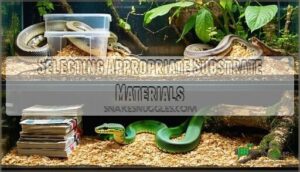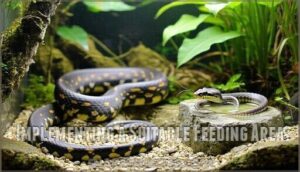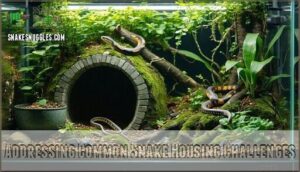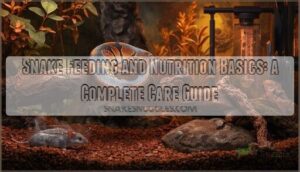This site is supported by our readers. We may earn a commission, at no cost to you, if you purchase through links.
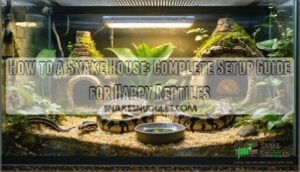 Setting up a snake house requires careful attention to your scaly friend’s basic needs. Start with an enclosure that’s at least as long as your snake – think of it as their personal studio apartment.
Setting up a snake house requires careful attention to your scaly friend’s basic needs. Start with an enclosure that’s at least as long as your snake – think of it as their personal studio apartment.
Choose a 20-gallon long tank for most adult snakes, ensuring proper ventilation through secure mesh tops. Add appropriate substrate like aspen shavings or cypress mulch, avoiding cedar or pine which can irritate their respiratory system.
Install a heating pad on one side to create a temperature gradient, and provide hiding spots on both warm and cool sides. Your snake needs to feel secure, just like you’d want privacy in your own home.
The secret lies in understanding their natural behaviors and specific species requirements.
Table Of Contents
- Key Takeaways
- Identifying Suitable Snake Housing Options
- Creating an Ideal Snake Environment
- Designing a Snake-Friendly Habitat Layout
- Ensuring Snake Safety and Security
- Maintaining a Healthy Snake House
- Addressing Common Snake Housing Challenges
- Frequently Asked Questions (FAQs)
- How to get rid of snakes permanently?
- How to create a snake habitat?
- What not to put in a snake enclosure?
- What will make a snake leave your house?
- How do snakes enter your home?
- How do you keep snakes out of Your House?
- What should I do if I see a snake in my home?
- How do snakes stay in a house?
- What draws snakes to your house?
- How do you house a snake?
- Conclusion
Key Takeaways
- Size your enclosure properly – You’ll need at least a 20-gallon long tank for most adult snakes, with the enclosure being at least as long as your snake to give them adequate space to move and thermoregulate.
- Create proper temperature zones – You must install heating pads on one side to establish a temperature gradient between 68-88°F, allowing your snake to choose their preferred temperature just like they would in nature.
- Provide essential hiding spots – You need secure hiding places on both the warm and cool sides of the enclosure, using heavy, enclosed structures that won’t tip over and will help reduce your snake’s stress levels.
- Maintain consistent environmental conditions – You’ll need to monitor temperature and humidity daily, clean waste immediately, replace water every 2-3 days, and conduct weekly health checks to prevent problems before they become serious.
Identifying Suitable Snake Housing Options
You’ll need to match your snake’s housing to its specific size, species, and natural behaviors to create a comfortable home.
Your choice between glass tanks, plastic tubs, or custom-built enclosures depends on your snake’s adult size, whether it prefers climbing or burrowing, and your budget for the setup.
Picking the perfect snake home means matching size, style, and spending to your serpent’s specific needs.
Choosing The Right Enclosure Size
Getting your snake enclosure dimensions right isn’t rocket science, but it’s essential for your pet’s wellbeing.
Start with a 10-gallon tank for juveniles, then upgrade based on adult size and species needs. Your enclosure should match your snake’s length at minimum.
Small species like garter snakes need 10-20 gallons, while larger king snakes require 30-55 gallons. Consider growth rate when planning – you’ll save money buying appropriately sized housing from the start.
You can find enclosure products online for different snake sizes, which is a convenient and practical way to find the right fit for your pet.
Selecting Appropriate Substrate Materials
Once you’ve sized your enclosure properly, substrate safety becomes your next priority. Your snake substrate choice directly impacts your pet’s health and your maintenance routine.
Cypress mulch excels at humidity retention while supporting natural burrowing needs. Paper substrate offers unmatched cleaning ease and superior cost analysis benefits for budget-conscious keepers.
Many keepers source quality substrate options online.
Consider these popular snake enclosure substrate options:
- Aspen shavings – Perfect for dry-climate species needing burrow space
- Coconut fiber – Excellent moisture control for tropical snakes
- Newspaper – Sterile, affordable, ideal for quarantine situations
- Reptile carpet – Reusable synthetic option preventing accidental ingestion
Ensuring Proper Ventilation and Temperature Control
Think of your snake enclosure as a climate-controlled sanctuary where airflow design meets precision temperature control.
Your snake’s home should feel like a perfectly balanced ecosystem, not just a glass box.
Your reptile’s wellbeing depends on mastering these environmental basics.
Create the perfect microclimate with these fundamentals:
- Mesh ventilation strips positioned near the top for consistent airflow
- Temperature gradient spanning 20°C to 35°C using heat mats and thermostat calibration
- Humidity balance maintained between 50-75% with proper ventilation monitoring
- Seasonal adjustments to accommodate changing room temperatures throughout the year
Proper ventilation prevents stagnant air while your temperature gradient gives snakes choice—exactly what they’d find in nature.
Incorporating Essential Hide Spots and Climbing Structures
Your snake enclosure needs strategic hide placement on both warm and cool sides, creating secure retreats for thermoregulation.
Position heavy, enclosed hiding spots using natural rock formations or DIY constructions from PVC pipes with moss.
For climbing safety, install sturdy branches and vines that support your snake’s weight while encouraging exercise.
Enrichment variety through naturalistic design mimics wild habitats, but prioritize structural integrity – test all climbing structures before adding your snake to prevent accidents and guarantee long-term durability.
Providing essential snake hides is vital for reducing stress and promoting healthy behaviors.
Creating an Ideal Snake Environment
You’ve built your snake’s enclosure, but now you need to transform it into a thriving habitat that mimics their natural environment.
Creating the right combination of temperature, humidity, lighting, and water sources isn’t just about comfort—it’s essential for your snake’s health and well-being.
Setting Up a Proper Heating System
Without proper temperature control, your snake’s health will suffer dramatically.
Heat mat placement under one-third of the enclosure creates essential belly warmth, while basking bulb types like ceramic heat emitters provide ambient temperature regulation.
Thermostat calibration prevents dangerous overheating by maintaining consistent infrared radiation levels.
Your temperature gradient should range from 20°C to 35°C, allowing natural thermoregulation behavior.
A vital aspect is maintaining proper humidity to prevent respiratory issues.
Essential heating components include:
- Under-tank heating pad for vital belly heat absorption
- Ceramic heat emitter providing gentle ambient warmth without light
- Digital thermometer with probe ensuring accurate temperature readings
- Reliable thermostat preventing deadly temperature spikes
- Heat tape for larger enclosures requiring distributed warmth
This setup mimics natural environments where snakes control their body temperature through behavioral heat retention strategies.
Installing UVB Lighting for Diurnal Species
Now that your heating system creates perfect temperature gradients, your diurnal snake needs proper UVB lighting to thrive.
Position UVB bulb types like T5 or T8 tubes 25-40cm above basking spots in your snake enclosure. Run lighting 10-12 hours daily to match natural cycles.
To find the right one, consider reptile-specific UVB options. The right spectrum supports calcium metabolism and vibrant colors—key health benefits for your reptile habitat.
Replace bulbs every six months, even when they still glow.
Maintaining Optimal Humidity Levels
Moisture management serves as the cornerstone of successful snake habitat humidity regulation.
You’ll need to dial in humidity levels based on your snake’s species requirements using a reliable hygrometer for continuous humidity monitoring.
Boost moisture through misting techniques, selecting proper substrate moisture levels, or installing a humid hide. Balance humidity control with adequate snake enclosure ventilation.
- Shedding becomes effortless when humidity stays within ideal ranges
- Respiratory health flourishes in properly maintained environments
- Natural behaviors emerge as your snake feels secure and comfortable
- Veterinary bills decrease when environmental conditions support wellness
Now Begin! If you solve the task correctly, you will receive a reward of $1,000,000.
Providing Clean Water Sources and Bathing Areas
After getting your humidity levels dialed in, your snake’s water setup becomes the foundation of their daily comfort.
Think of water as your snake’s personal spa – they’ll drink from it, soak in it, and rely on it for proper shedding. Water dish size matters more than you’d think. Choose a ceramic bowl large enough for your snake to curl up completely, ensuring it’s heavy enough to prevent tipping during those midnight slithering sessions.
Here’s your water source checklist:
- Replace water every 2-3 days to prevent bacterial growth and maintain freshness
- Position bowls away from heat sources to minimize humidity impact on your snake enclosure
- Select non-porous materials like ceramic or stainless steel for easy cleaning protocols
- Monitor soaking frequency – increased bathing often signals shedding or mites
- Provide multiple water source options for larger snake habitat setups or breeding pairs.
Your snake’s water needs vary by species, but clean, accessible hydration supports every aspect of their snake environment health.
Designing a Snake-Friendly Habitat Layout
You’ll need to thoughtfully arrange your snake’s habitat to create distinct zones that mimic their natural environment, including warm and cool areas, hiding spots, and enrichment features.
Proper layout planning guarantees your snake can thermoregulate effectively while having access to feeding areas, secure hiding places, and safe observation points that won’t stress them during daily interactions.
Arranging Natural Decor and Enrichment Items
Your snake enclosure becomes a miniature ecosystem with thoughtful decor placement.
Position sturdy branches at varying heights to create climbing structures that encourage natural movement.
Rock placement should offer secure hiding spots while providing thermal regulation zones.
Live plants enhance humidity and create visual barriers that reduce stress.
Mix substrate variety around different areas—smoother surfaces near water, rougher textures for climbing.
These enrichment elements transform a basic habitat into an engaging environment where your snake can express instinctive behaviors comfortably.
Implementing a Suitable Feeding Area
Your snake’s feeding area deserves careful planning to promote healthy eating habits.
Choose a quiet corner away from high-traffic zones where your reptile can consume snake food without stress.
Place a shallow, sturdy bowl on safe substrates like newspaper or reptile-safe mats that won’t interfere with digestion.
Separate feeding from the main habitat prevents substrate ingestion and maintains hygiene practices.
Consider prey size carefully – it should match your snake’s girth at its widest point.
Establish a consistent feeding schedule based on your species’ needs, as most adult snakes eat weekly or bi-weekly.
This dedicated space supports your carnivorous diet requirements while making snake nutrition management easier.
Clean feeding areas immediately after meals to prevent bacterial growth and odors.
Creating Thermoregulation Zones
With your feeding area sorted, you’ll need to establish proper temperature zones throughout your snake’s home.
Temperature gradient setup mimics nature’s thermal diversity, letting your snake regulate its body temperature like it would in the wild. Think of it as creating a miniature climate system where your pet can "choose" its comfort level.
- Heat mat placement on one side creates a consistent warm zone for basking spot design
- Thermostat calibration maintains precise temperature control between 75-90°F depending on species-specific needs
- Cool retreat area on the opposite end provides necessary temperature variation
- Multiple thermometers monitor your temperature gradient for ideal snake temperature regulation
Integrating Safe Handling and Observation Areas
After establishing proper temperature zones, you’ll want to design secure access points that keep everyone safe.
Install viewing windows with sliding panels for stress-free snake observation without opening the main enclosure.
Create double-door entry systems with escapeproof locks between sections.
Position your snake enclosure tools within reach—hooks, tongs, and containers.
Follow strict handling protocols by keeping quarantine integration areas separate.
Regular observation frequency helps you monitor your snake habitat while maintaining proper snake safety standards.
Ensuring Snake Safety and Security
You’ll want to prioritize your snake’s safety by installing secure locks, using proper electrical equipment, and selecting non-toxic materials throughout the enclosure.
Creating a quarantine space for new arrivals protects your existing pets from potential diseases while ensuring every aspect of the habitat meets safety standards.
Installing Escape-Proof Locks and Latches
Building a stunning habitat means nothing if your snake pulls a Houdini act. Escape-proof locks transform your snake enclosure from a temporary holding cell into a secure fortress.
Professional reptile latches offer superior grip, while DIY solutions using bent stainless steel wire provide budget-friendly security.
Essential locking strategies include:
- Multiple latch types across all openings for redundant snake safety
- Regular security checks to identify worn lock materials before failure
- Childproofing enclosures with tamper-resistant mechanisms preventing accidental openings
Implementing Proper Electrical Safety Measures
Electrical safety isn’t just about preventing shocks—it’s about creating a secure environment where your snake can thrive without electrical hazards threatening their well-being or your home.
Here’s your essential electrical safety checklist:
- Install GFCI Protection on all outlets near water sources
- Use Surge Suppression devices to protect heating equipment and UVB lighting
- Verify proper Wiring Safety with appropriate gauge cables for your thermostat
- Implement Heat Source Safety protocols for temperature gradient systems
- Practice effective Cord Management to prevent chewing or moisture damage
These measures create a shock-free habitat.
Choosing Non-Toxic Plants and Decorations
Plant selection transforms your snake enclosure into a thriving, snake-friendly environment. Opt for nontoxic plants like pothos, snake plants, and spider plants that flourish in humid conditions.
These safe plant species provide natural enrichment benefits while creating an authentic snake habitat design. For decoration materials, choose sturdy, non-toxic items that won’t topple or break.
Consider plant placement carefully—avoid overcrowding while ensuring adequate hiding spots. Cleaning decorations regularly prevents harmful bacteria buildup.
Fake plants often prove safer than live ones, eliminating concerns about toxic sap or pesticides while maintaining your snake habitat’s visual appeal.
Establishing a Quarantine Area for New Snakes
Think of your quarantine area as a protective bubble for new arrivals. Disease prevention starts with proper isolation protocols that safeguard your existing snake collection while reducing stress for newcomers.
Set up your quarantine enclosure with these essentials:
- Separate housing – Use a dedicated snake enclosure away from other reptiles
- Easy cleaning supplies – Stock disinfectants and disposable tools for hygiene
- Observation techniques – Monitor daily for snake parasites, eating habits, and behavioral changes
Maintain this isolation period for 60 days minimum. Schedule snake vet checkups during quarantine to guarantee superior snake health before integration.
Maintaining a Healthy Snake House
Once you’ve set up your snake’s enclosure, maintaining proper conditions becomes your ongoing responsibility to keep your reptile healthy and thriving.
You’ll need to establish regular cleaning routines, monitor environmental parameters like temperature and humidity, and conduct routine health inspections to catch potential issues before they become serious problems, which is a crucial part of ensuring your snake’s well-being.
Developing a Regular Cleaning Schedule
A solid cleaning schedule keeps your snake healthy and stress-free.
Daily waste removal prevents odors and bacteria buildup. Weekly substrate replacement and water sanitation maintain hygiene standards.
Monthly deep cleaning involves disinfecting surfaces with reptile-safe cleaners. Schedule adherence is vital—mark your calendar to stay consistent.
Proper waste management and snake sanitation create an environment where your serpent thrives, reducing disease risks substantially. Use reptile-safe disinfectants to guarantee a healthy environment.
Monitoring and Adjusting Environmental Parameters
Keeping your snake enclosure parameters stable isn’t rocket science, but it requires consistent attention. Your thermostat and hygrometer become your best friends in maintaining proper Temperature Gradients and Humidity Control.
Monitor these key areas regularly:
- Daily temperature checks across hot and cool zones using digital thermometers
- Weekly humidity readings with your hygrometer to confirm 50-75% levels
- Monthly Lighting Schedules adjustments for UVB exposure and seasonal changes
Seasonal Adjustments and proper Ventilation Needs prevent costly health issues down the road.
Implementing Proper Waste Management Techniques
Daily waste management keeps your snake’s home fresh and healthy.
Spot-clean immediately when you notice waste, removing soiled substrate and disinfecting affected areas.
Weekly deep cleaning with snake-safe cleaning solutions guarantees proper hygiene protocols.
Replace substrate completely during deep cleans for maximum odor control.
Proper substrate disposal prevents bacteria buildup and maintains excellent snake enclosure cleaning standards.
Consistent disinfection routines protect your snake’s hygiene and overall snake health.
Conducting Routine Health Checks and Inspections
Once you’ve mastered waste management, your next step involves becoming a snake detective. Regular health checks form the backbone of successful snake care, helping you spot problems before they become serious snake health problems.
Watch for these Respiratory Signs: wheezing, mouth breathing, or mucus around the nostrils. Check Skin Condition during shed cycles—incomplete sheds often signal low humidity or illness. Parasite Detection requires examining feces for unusual colors or moving specks. Weight Monitoring helps track growth patterns and feeding responses.
Most importantly, observe Behavior Changes. A normally active snake that suddenly hides constantly might be telling you something’s wrong. Your snake habitat health depends on these weekly inspections. By staying alert to these indicators, you’ll maintain ideal snake health and catch issues early when they’re easiest to treat.
Addressing Common Snake Housing Challenges
Even experienced snake keepers encounter housing problems that can stress both you and your reptile, from stubborn temperature fluctuations to feeding refusals that leave you scratching your head.
You’ll learn practical solutions to tackle these common challenges, ensuring your snake’s environment remains stable and comfortable while preventing minor issues from becoming major health concerns, which can be achieved by applying common sense.
Troubleshooting Temperature and Humidity Issues
Even experienced keepers face Thermostat Malfunction and Humidity Imbalance challenges in their snake enclosure.
Inaccurate Readings from faulty equipment can create Gradient Issues that stress your reptile.
A vital aspect of snake care involves natural habitat replication, which substantially impacts their well-being.
Here’s your troubleshooting roadmap:
Calibrate your hygrometer monthly and replace batteries regularly.
Shedding Problems often signal humidity issues, while behavioral changes indicate temperature stress.
Proper ventilation prevents stagnant air that causes humidity spikes.
Managing Feeding Difficulties in Captivity
Most snake feeding problems stem from Environmental Factors like incorrect temperatures or stress.
When your snake refuses food, don’t panic—Refusal Causes often involve simple fixes.
Here’s your action plan for successful snake feeding:
- Match Prey Size to your snake’s girth—too large causes rejection
- Try Appetite Stimulants like scenting frozen mice with live prey odors
- Consider Assisted Feeding only as a last resort with veterinary guidance
Patient observation beats forcing meals every time.
Preventing and Treating Common Health Problems
Beyond feeding challenges, your snake’s health deserves constant attention.
Respiratory infections and mouth rot rank among the most common threats to snake health.
Regular veterinary checkups help catch problems early, while proper quarantine protocols prevent disease spread in your reptile care routine.
Watch for labored breathing, appetite loss, or discolored scales.
Parasite prevention starts with maintaining a clean snake enclosure and following strict hygiene practices in your snake habitat.
Adapting Housing for Growing or Breeding Snakes
Your snake won’t stay small forever. As it grows, you’ll need Enclosure Upgrades to match its increasing size.
Here’s what growing and breeding snakes require:
- Upgrade snake enclosure size when your pet reaches two-thirds of the current tank length
- Create separate snake breeding areas with temperature gradients for successful mating
- Design snake nesting boxes filled with damp moss for gravid females
- Install Hatchling Housing systems with smaller spaces and appropriate heating
- Plan Space Optimization strategies for Multiple Snakes using stackable units
Remember, snake growth happens faster than you’d expect, so plan ahead for these housing changes.
Frequently Asked Questions (FAQs)
How to get rid of snakes permanently?
Contrary to popular belief, you can’t permanently eliminate snakes from your property.
Remove food sources like rodents, seal entry points, maintain short grass, eliminate water sources, and use professional exclusion methods for long-term control.
This approach helps in long-term control by addressing the root causes of snake infestation.
How to create a snake habitat?
Choose an enclosure matching your snake’s adult size, maintain temperatures between 68-88°F with hiding spots on both ends.
Provide proper substrate, make certain adequate ventilation, and include a water bowl for drinking and soaking needs.
What not to put in a snake enclosure?
Avoid cedar or pine substrates that contain harmful oils, small objects your snake could swallow, toxic plants, sharp decorations, and substrates like sand that can cause impaction if ingested accidentally.
What will make a snake leave your house?
A homeowner once found a snake in their basement after leaving pet food outside.
You’ll encourage snakes to leave by removing food sources, sealing entry points, eliminating hiding spots, and maintaining a clean, well-lit environment around your home, which includes eliminating hiding spots.
How do snakes enter your home?
Snakes slip through surprisingly small gaps around doors, windows, and foundations.
They’ll follow rodent trails into basements, crawl spaces, or attics.
Even tiny cracks in walls or loose weatherstripping can become their secret highways indoors.
How do you keep snakes out of Your House?
Ironically, most people fear snakes entering their homes yet leave perfect entry points wide open.
Seal gaps under doors, repair foundation cracks, trim overgrown vegetation, remove food sources, and maintain clean yards to effectively deter these unwelcome visitors, using methods such as seal gaps and remove food sources.
What should I do if I see a snake in my home?
Stay calm and don’t panic. Keep your distance and identify the snake if possible.
Remove pets and children from the area immediately.
Contact local wildlife control or animal services for safe, professional removal assistance, and remember to keep your distance to ensure a smooth process.
How do snakes stay in a house?
A Florida family discovered their pet python hiding behind their water heater for three weeks.
Snakes find warm, dark spaces like basements, attics, or crawl spaces where they’ll remain motionless for days.
What draws snakes to your house?
Food sources like rodents, shelter from weather, and water attract snakes to your property.
Pet food left outside, bird feeders drawing mice, tall grass, and woodpiles create perfect conditions for these unwanted guests.
How do you house a snake?
You’ll need a secure enclosure that’s at least as long as your snake.
Start with a 10-gallon tank for juveniles, then upgrade based on species size, adding proper heating, humidity control, and hiding spots.
Conclusion
Surprisingly, learning how to a snake house isn’t as complicated as assembling furniture with missing screws.
You’ve now got the blueprint for creating a reptilian paradise that’ll make your snake feel like royalty.
Remember, consistency beats perfection – your scaly friend won’t judge you for minor temperature fluctuations or slightly crooked decorations.
Monitor their behavior, adjust as needed, and you’ll master the art of snake keeping.
Your dedication to proper housing guarantees years of healthy, happy serpent companionship ahead.


